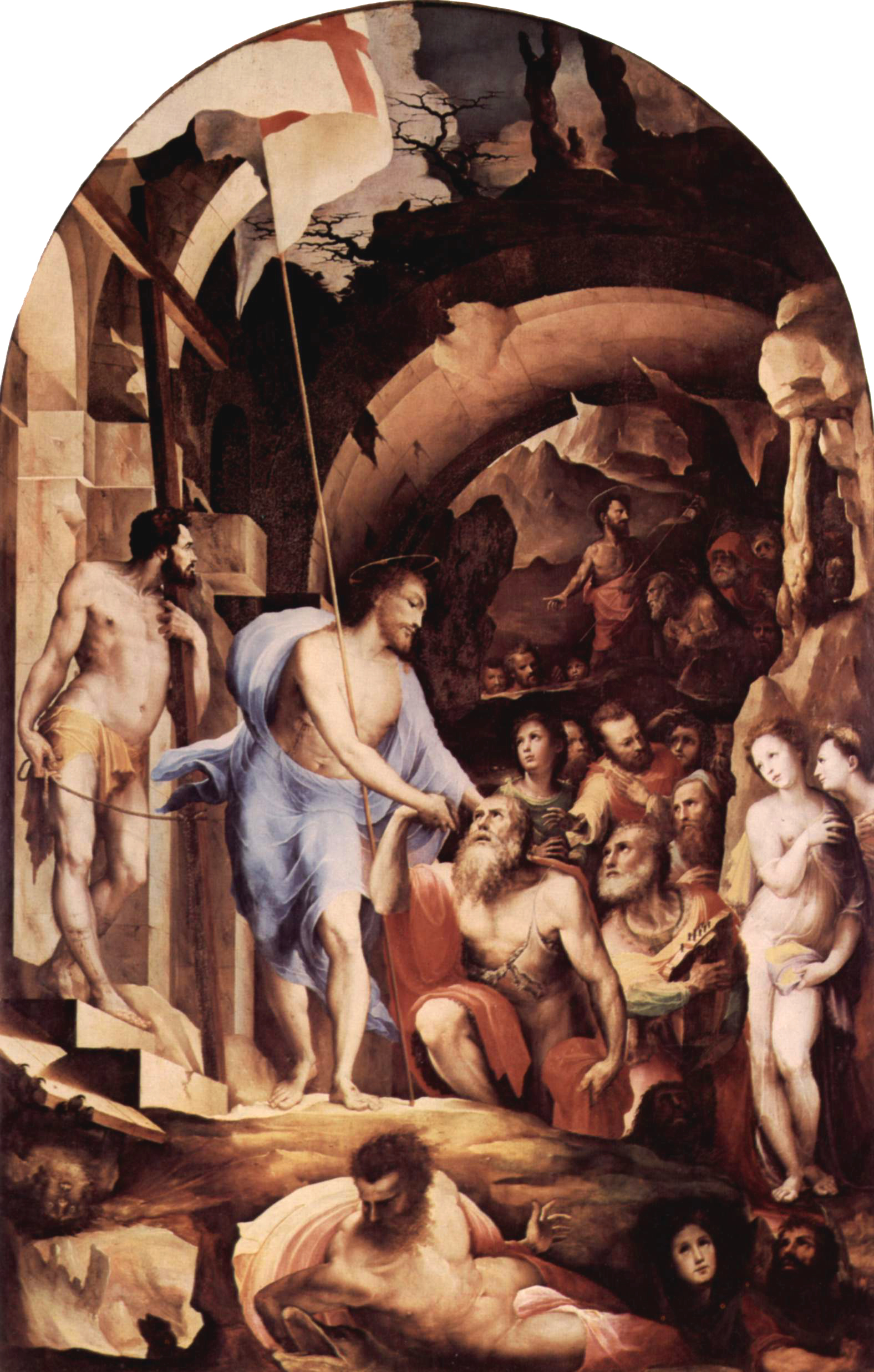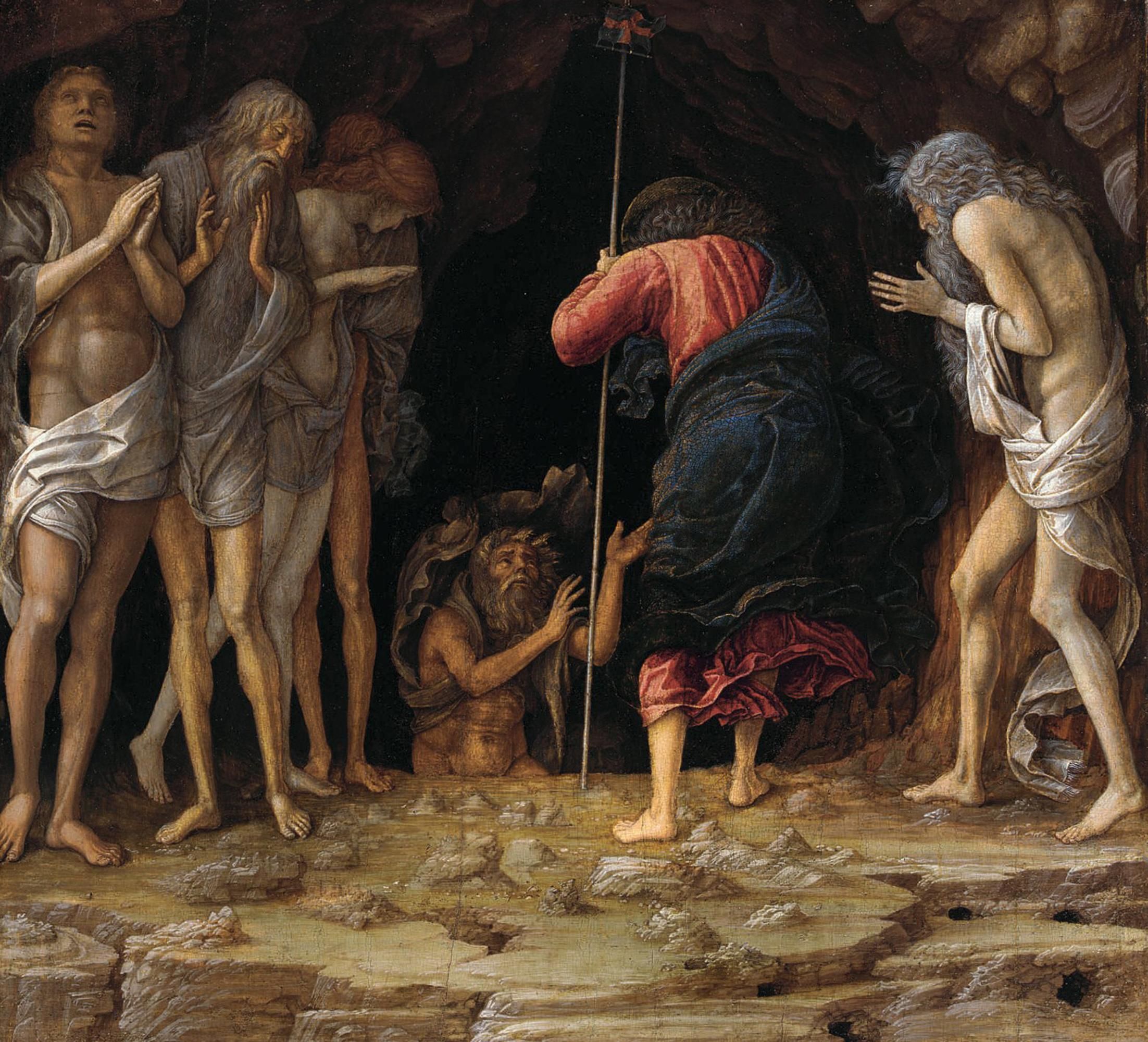
-“Jesus in Limbo” (c. 1530-1535) by Domenico Beccafumi, oil on panel, now in the Sienese Grand Masters room in the Pinacoteca Nazionale in Siena, Christ descending to the souls in Limbo, including Adam in the centre, a nude Eve to the right and between them King David holding a sceptre. In the far background John the Baptist guides the souls, while at the bottom is a river divinity. To the left is a figure holding a cross, possibly St Dismas the good thief, please click on the image for greater detail.

-by Tim Staples, Tim was raised a Southern Baptist. Although he fell away from the faith of his childhood, Tim came back to faith in Christ during his late teen years through the witness of Christian televangelists. Soon after, Tim joined the Marine Corps.
“The traditional teaching concerning Limbo—“the Limbo of children,” as it has been called—has a fascinating history in Catholic theology. It has never been the object of a definition by either the ordinary Magisterium, requiring “religious submission of mind and will” (Lumen Gentium 25), or any definitive act of the magisterial authority of the Church, which would require the assent of divine and Catholic faith (CIC 750, para. 1). However, it was considered a teaching in the category of “common doctrine” in the past because it had been alluded to by the Magisterium over the centuries as well as taught by theologians. Thus, the Church has historically taught the faithful are not permitted to assert there is no Limbo. At least, not with any magisterial backing. But Catholics have never been required to believe in Limbo as a Catholic doctrine.
Some will disagree with me here, citing Pope Urban IV, who declared in his Papal Bull of Union with the Greeks, Laetentur Caeli (“Let the Heavens Rejoice!”) of July 6, 1439, during the Council of Florence,
As for the souls of those who die in actual mortal sin or with original sin only, they go down immediately to hell, to be punished, however, with different punishments.
Isn’t that an example of a pope teaching on Limbo? Well, let’s look at what the pope is actually saying.

-“Descent into Limbo” by Andrea Mantegna, 1492, tempera and gold on panel, 38.8 cm × 42.3 cm (15.3 in × 16.7 in), the Barbara Piasecka Johnson Collection in Princeton, New Jersey, please click on the image for greater detail.
There are two teachings here. First, if a soul dies in mortal sin, he will go immediately into hell, where he will suffer torments (positive punishments) for all eternity. That teaching is definitive and has been taught and repeated by the Magisterium for many centuries (see the Fourth Lateran Council, Constitutions, Confession of Faith; Pope Benedict XII, Constitution, Benedictus Deus; CCC 1033-1037, etc.). And second, the pope taught that if a soul dies with the stain of original sin only, he descends into “hell,” but only in the sense that he cannot attain the beatific vision of God.
Pope Urban is here using scholastic terms, which distinguish “the pain of loss” (poena damni, which means deprivation of the beatific vision, which would be experienced by both those who die with mortal sin on their souls and those who die with only original sin) from “the pain of sense” (poena sensus, which means the positive punishments of hell experienced only by the souls who die with mortal sin on their souls). The souls who die with original sin only on their souls experience only “the pain of loss.”
Pope John XXII made the distinction clearer—between the “place” those “who die in actual mortal sin” would go to and where those with original sin only go—in Nequaquam sine dolore (Not at All Without Pain”), of Nov. 21, 1321:
The souls, however, of those who die in mortal sin or with original sin only descend immediately into hell; to be punished, though, with different pains and in different places.
The use of ac locis disparibus puniendas, which means “in different places and punishments,” which uses the same adjective disparibus (different) to describe both “places” and “punishments,” makes clear that the punishment of those who die in mortal sin is essentially different from the punishment of souls with “original sin alone” on their souls.
This is, no doubt, an allusion to Limbo—i.e., “the place” a soul would go if he were to have only the stain of original at the time of his death. But Limbo itself is neither mentioned nor defined.
As an aside for now, when it comes to magisterial teachings on hell (where souls experience the poena sensus as well as poena damni), the Church has made very clear not only the existence of hell, but that there both are and will be real souls present there for all eternity. But with regard to Limbo, the Church has only alluded to its existence as a possibility. She has never stated that there will be souls actualized there. That is another question we will tackle below.
For now, we can safely say that the above-cited magisterial documents are not examples of Limbo being presented as an object of a definition. However, we do have cases like Pope Pius VI’s constitution Auctorem Fidei, August 28, 1794, where he explicitly condemned as false the idea that “the limbo of children” is “a Pelagian fable.”
Thus, the Catholic faithful were never required to believe in Limbo, but they were not free to condemn it, either.
You may have read, however, that the Church “abolished Limbo” a few years ago. Here’s what that charge refers to: in 2007, the International Theological Commission, which is a department of the Roman Curia under the Dicastery for the Doctrine of the Faith and serves as an advisory board for the dicastery, issued a document called “The Hope of Salvation for Infants Who Die Without Being Baptized.” It was published with the approval of Pope Benedict XVI and taught that the Church has reduced the teaching of Limbo from the level of “common doctrine” among theologians to “a possible theological hypothesis.” It did not do what many expected—that is, completely abandon Limbo, as Benedict had said the Church should do back when he was Cardinal Ratzinger. But it did reduce the teaching’s prominence.
“Our conclusion is that the many factors that we have considered above give serious theological and liturgical grounds for hope that unbaptized infants who die will be saved and enjoy the beatific vision. We emphasize that these are reasons for prayerful hope, rather than grounds for sure knowledge. There is much that simply has not been revealed to us. We live by faith and hope in the God of mercy and love who has been revealed to us in Christ, and the Spirit moves us to pray in constant thankfulness and joy.
What has been revealed to us is that the ordinary way of salvation is by the sacrament of baptism. None of the above considerations should be taken as qualifying the necessity of baptism or justifying delay in administering the sacrament. Rather, as we want to reaffirm in conclusion, they provide strong grounds for hope that God will save infants when we have not been able to do for them what we would have wished to do, namely, to baptize them into the faith and life of the Church.”
What does this mean? Is there any real change here? Yes, there is.
It means that a Catholic is still free to present this teaching as a possibility, but another Catholic can now say, “I ain’t buying it!” . . . and then present his reasons why. In fact, the ITC helps in that regard. In sections 5-7 of “The Hope of Salvation for Infants Who Die Without Being Baptized,” the commission lists what I will number as three essential reasons—or categories of reasons—why Catholics can have hope that unbaptized infants will be saved.
- Given the principle of lex orandi lex credendi, the liturgy has never mentioned Limbo. Couple with that the fact that we have the Feast of the Holy Innocents, where we liturgically venerate as martyrs unbaptized children two years of age and younger, this becomes positive evidence in favor of at least some unbaptized children being saved.
- The document adds CCC 1261: “The great mercy of God who desires all men should be saved (1 Tim. 2:4), and Jesus’ tenderness toward children which caused him to say: ‘Let the children come to me, do not hinder them’ (Mark 10:14), allow us to hope that there is a way of salvation for children who have died without baptism” (5). I would add here the fact that Luke 18:15-17 uses the Greek word brephe, or “infant” in this same context of Jesus saying, “Let the infants some to me.” This most manifestly brings out the truth that these unbaptized babies are in absolute need of the prayers of the Church because they do not have the ability to pray for themselves. The good news? Holy Mother Church does indeed pray for them! This is a powerful reason for hope that these babies will be saved.
- The document makes a powerful point in reminding us that “the Church respects the hierarchy of truths and therefore begins by clearly reaffirming the primacy of Christ and his grace, which has priority over Adam and sin.” This is not to diminish in any way the necessity of baptism. That teaching is de fide. But it is to show, given the fact that the Church acknowledges other ways people who are not baptized can experience the grace of the sacrament without the sacrament en re, that it is reasonable to think “that infants, [who] for their part, do not place any personal obstacle in the way of redemptive grace,” would be able to receive salvific grace for salvation
Given all of these “reasons for hope,” one might think the conclusion of the commission would be absolutely certain and definitive. But it was not. The conclusion was that we cannot have the same level of certainty of the salvation of infants who die without baptism that we do for infants who have been baptized. Hence, the commission emphasized what the Church has emphasized for 2,000 years: there still is and always will be the absolutely crucial need for parents to baptize their babies! This truth is paramount.
Again, Limbo, or something similar, is still a possible theological hypothesis. But we also have reason to hope that these children will, in fact, be saved. We can do so because the Church entrusts these children to our merciful God (CCC 1261), whose salvific will for all is a matter of public revelation (2 Peter 3:9, 1 Tim. 2:4, etc.). Also, we have reason to hope that the prayer of the Church liturgically and the prayer of Christians may well suffice to bring the grace of baptism to these unbaptized infants in need.”
Love & truth,
Matthew
